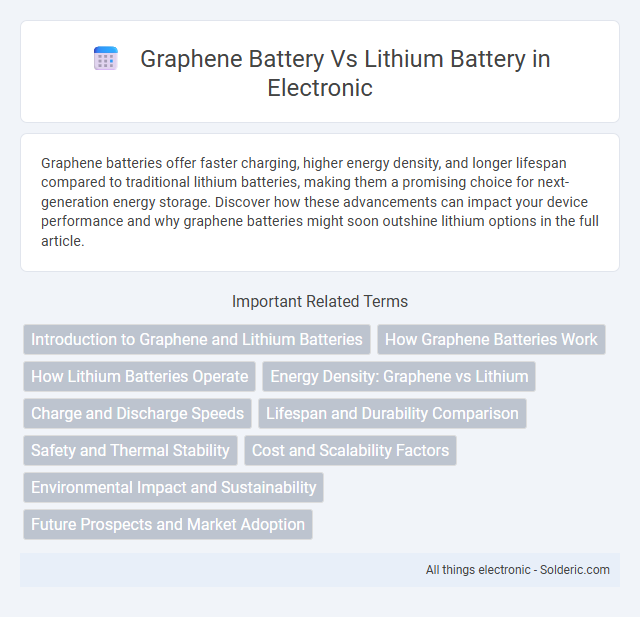Graphene batteries offer faster charging, higher energy density, and longer lifespan compared to traditional lithium batteries, making them a promising choice for next-generation energy storage. Discover how these advancements can impact your device performance and why graphene batteries might soon outshine lithium options in the full article.
Comparison Table
| Feature | Graphene Battery | Lithium Battery |
|---|---|---|
| Energy Density | Up to 2-3x higher than lithium | Standard baseline |
| Charging Speed | Fast charging (minutes) | Slow to moderate (hours) |
| Cycling Stability | Longer lifespan, 2000+ cycles | Typically 500-1000 cycles |
| Thermal Management | Excellent heat dissipation | Prone to overheating |
| Cost | Higher due to advanced materials | Lower, mass-produced |
| Environmental Impact | More eco-friendly, recyclable | Less eco-friendly, toxic waste |
| Weight | Lighter, improves portability | Heavier |
| Use Cases | High-performance devices, EVs | Smartphones, laptops, EVs |
Introduction to Graphene and Lithium Batteries
Graphene batteries leverage the exceptional electrical conductivity and mechanical strength of graphene to enhance energy storage performance compared to traditional lithium batteries. Lithium batteries rely on lithium ions moving between anode and cathode to store and release energy, while graphene batteries incorporate graphene materials to improve charge speed, capacity, and lifespan. You can expect graphene batteries to offer faster charging times, higher energy density, and longer cycle life due to their advanced nanostructure design.
How Graphene Batteries Work
Graphene batteries utilize a single layer of carbon atoms arranged in a hexagonal lattice to enhance the conductivity and strength of the electrode materials, allowing for faster charging and higher energy density compared to traditional lithium batteries. The unique structure of graphene enables efficient electron transport and better thermal management, which improves battery lifespan and safety. Your device can benefit from quicker charge cycles and longer usage times thanks to these advanced electrochemical properties.
How Lithium Batteries Operate
Lithium batteries operate by shuttling lithium ions between the anode and cathode through an electrolyte during charge and discharge cycles, enabling efficient energy storage and release. The anode typically consists of graphite, while the cathode is composed of lithium metal oxides, allowing high energy density and long cycle life. These batteries rely on electrochemical reactions that convert chemical energy into electrical energy, making them the dominant technology for portable electronics and electric vehicles.
Energy Density: Graphene vs Lithium
Graphene batteries offer significantly higher energy density compared to traditional lithium batteries, enabling longer battery life and faster charging times. The unique structure of graphene allows for greater electron mobility and efficient heat dissipation, resulting in improved performance and stability under high load conditions. Lithium batteries typically have lower energy density, leading to shorter usage periods and longer recharge cycles relative to graphene-based alternatives.
Charge and Discharge Speeds
Graphene batteries offer significantly faster charge and discharge speeds compared to traditional lithium batteries, enabling quicker power replenishment and enhanced energy delivery. Their high electrical conductivity and larger surface area improve electron transfer rates, resulting in shorter charging times and rapid energy output. If you prioritize fast charging and efficient power use, graphene battery technology provides a superior advantage over conventional lithium-ion options.
Lifespan and Durability Comparison
Graphene batteries offer a significantly longer lifespan than traditional lithium batteries, often lasting up to three times more charge cycles due to their enhanced thermal conductivity and structural stability. Their durability is superior, resisting swelling and degradation under high temperatures, which ensures consistent performance over time. Your investment in graphene technology translates into reduced replacement frequency and increased reliability for high-demand applications.
Safety and Thermal Stability
Graphene batteries exhibit superior safety and thermal stability compared to traditional lithium batteries due to their enhanced heat dissipation properties and resistance to thermal runaway. Lithium batteries are more prone to overheating and potential fires because of their flammable electrolyte and less efficient heat management. Your choice of a graphene battery can significantly reduce the risk of overheating, making it a safer option for high-performance and long-duration applications.
Cost and Scalability Factors
Graphene batteries generally have higher initial production costs than lithium batteries due to advanced materials and manufacturing complexity but offer potential for lower long-term expenses through improved durability and faster charging capabilities. Lithium batteries benefit from established large-scale production infrastructure, driving down unit costs and enabling broad market adoption. Scalability of graphene batteries remains limited by current manufacturing challenges, while lithium battery technology continues to expand rapidly with ongoing process optimizations and supply chain maturity.
Environmental Impact and Sustainability
Graphene batteries offer a more sustainable alternative to lithium batteries due to their longer lifespan and higher energy efficiency, reducing the frequency of replacements and electronic waste. Manufacturing lithium batteries involves extensive mining of cobalt and lithium, which causes environmental degradation and raises ethical concerns. Graphene's carbon-based composition is more environmentally friendly and easier to recycle, contributing to lower ecological footprints in energy storage solutions.
Future Prospects and Market Adoption
Graphene batteries offer significant future prospects due to their faster charging speeds, higher energy density, and longer lifespan compared to traditional lithium batteries. Market adoption is expected to accelerate as industries prioritize sustainable energy solutions and seek devices with enhanced performance and durability. Your investment in products powered by graphene technology may benefit from the growing demand and innovation in electric vehicles, consumer electronics, and renewable energy storage.
Graphene battery vs Lithium battery Infographic

 solderic.com
solderic.com